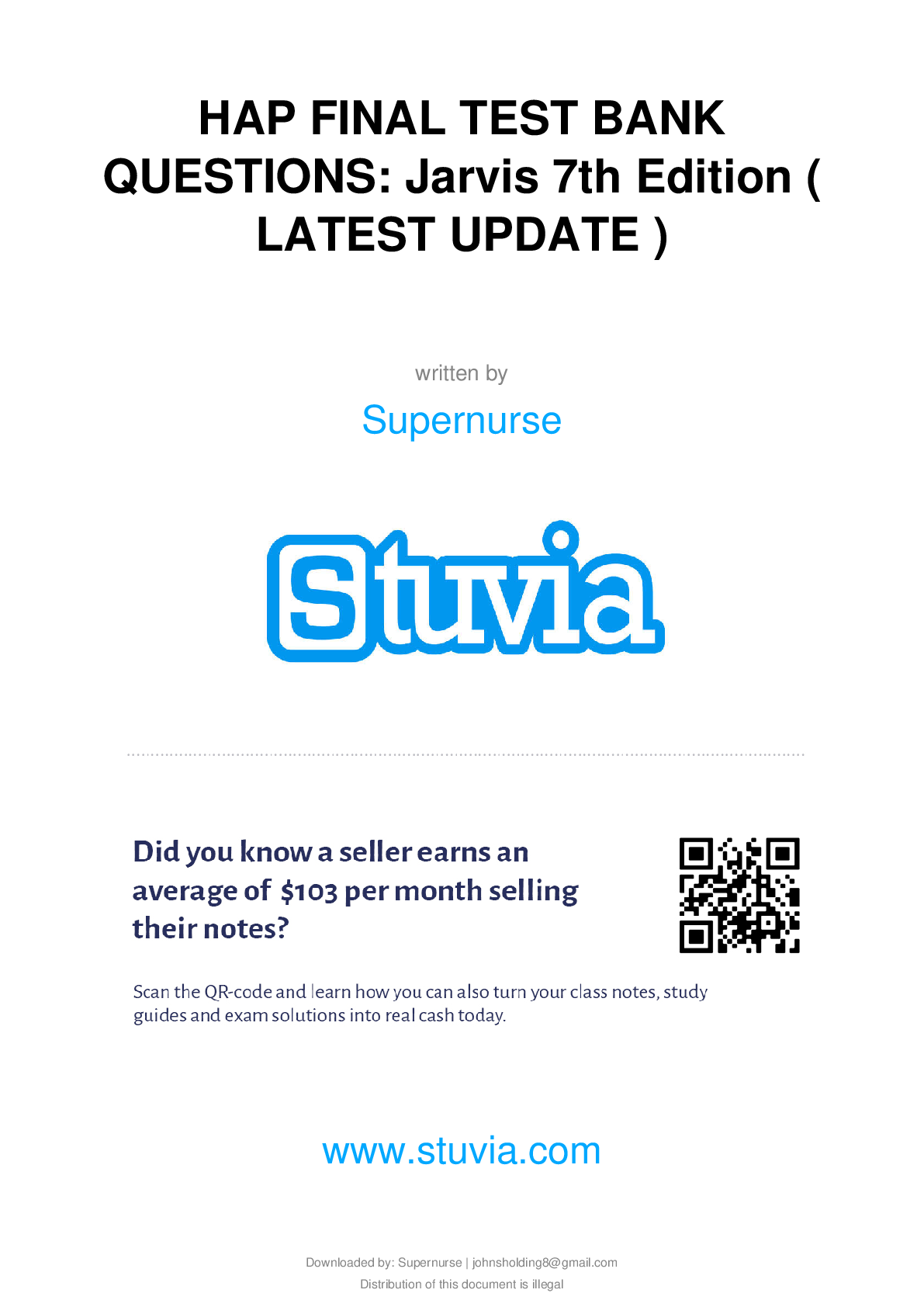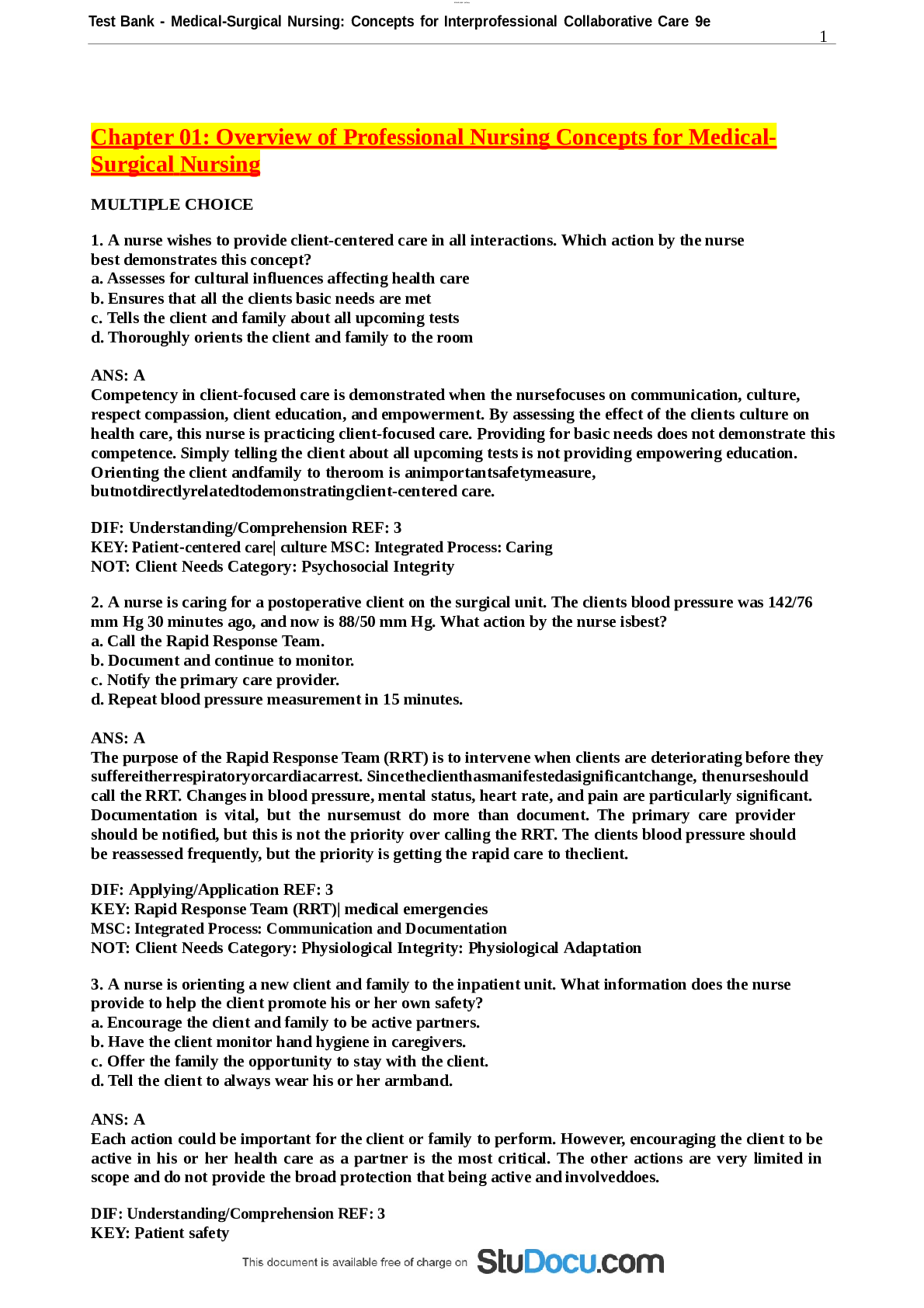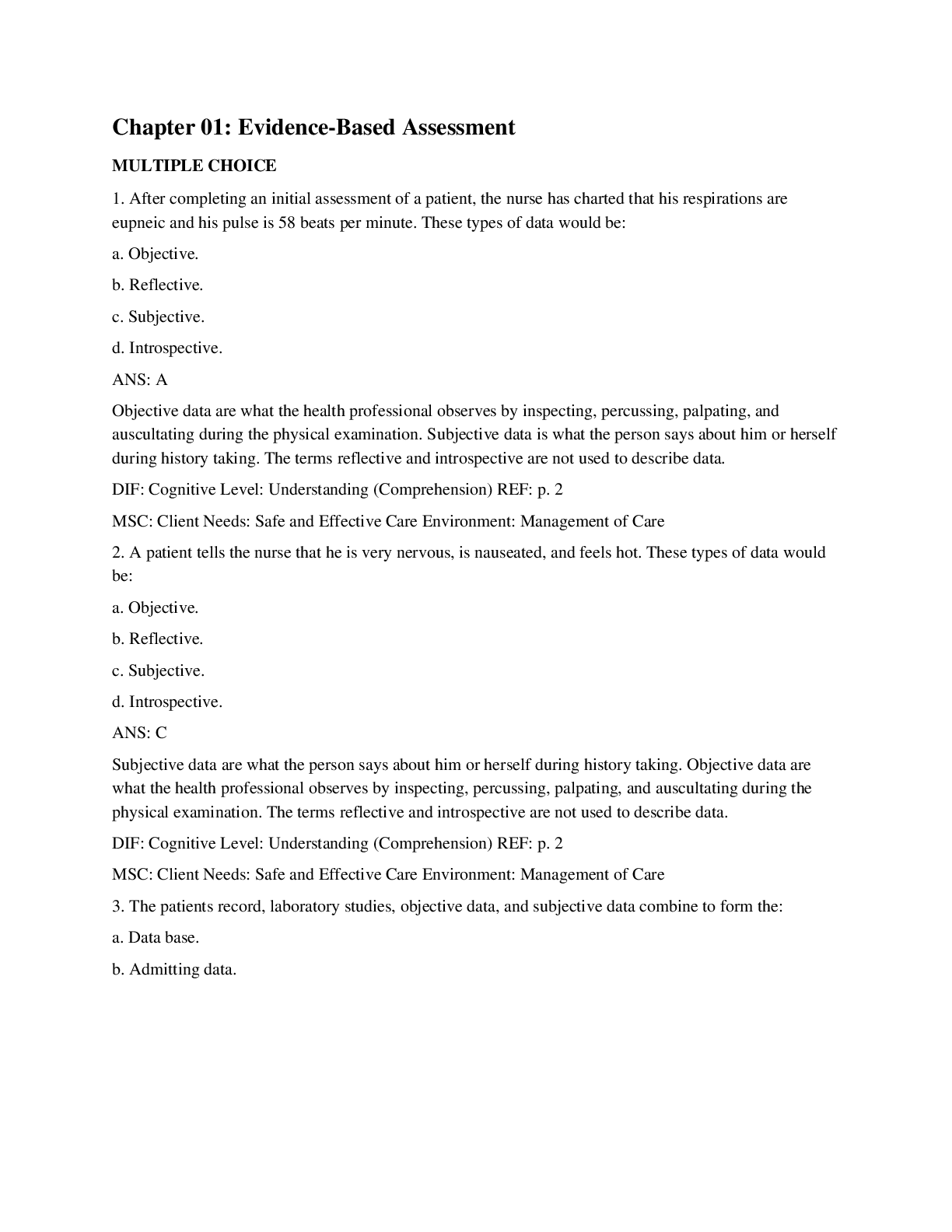*NURSING > TEST BANKS > HAP FINAL TEST BANK QUESTIONS: Jarvis 7th Edition ( LATEST UPDATE ) (All)
HAP FINAL TEST BANK QUESTIONS: Jarvis 7th Edition ( LATEST UPDATE )
Document Content and Description Below
HAP FINAL TEST BANK QUESTIONS: Jarvis 7th Edition Chapter 01: Evidence-Based Assessment MULTIPLE CHOICE 1. After completing an initial assessment of a patient, the nurse has charted that his respirati... ons are eupneic and his pulse is 58 beats per minute. These types of data would be: a. Objective. b. Reflective. c. Subjective. d. Introspective. ANS: A Objective data are what the health professional observes by inspecting, percussing, palpating, and auscultating during the physical examination. Subjective data is what the person saysabout him or herself during history taking. The terms reflective and introspective are not used to describe data. 2. A patient tells the nurse that he is very nervous, is nauseated, and “feels hot.” These types of data would be: a. Objective. b. Reflective. c. Subjective. d. Introspective. ANS: C Subjective data are what the person says about him or herself during history taking. Objective data are what the health professional observes by inspecting, percussing, palpating, and auscultating during the physical examination. The terms reflective and introspective are not used to describe data. 3. The patient’s record, laboratory studies, objective data, and subjective data combine to form the: a. Data base. b. Admitting data. c. Financial statement. d. Discharge summary. ANS: A Together with the patient’s record and laboratory studies, the objective and subjective data form the data base. The other items are not part of the patient’s record, laboratory studies, or data. 4. When listening to a patient’s breath sounds, the nurse is unsure of a sound that is heard. The nurse’s next action should be to: a. Immediately notify the patient’s physician. b. Document the sound exactly as it was heard. c. Validate the data by asking a coworker to listen to the breath sounds. d. Assess again in 20 minutes to note whether the sound is still present. ANS: C When unsure of a sound heard while listening to a patient’s breath sounds, the nurse validates the data to ensure accuracy. If the nurse has less experience in an area, then he or she asks an expert to listen. 5. The nurse is conducting a class for new graduate nurses. During the teaching session, the nurse should keep in mind that novice nurses, without a background of skills and experience from which to draw, are more likely to make their decisions using: a. Intuition. b. A set of rules. c. Articles in journals. d. Advice from supervisors. ANS: B Novice nurses operate from a set of defined, structured rules. The expert practitioner uses intuitive links. 6. Expert nurses learn to attend to a pattern of assessment data and act without consciously labeling it. These responses are referred to as: a. Intuition. b. The nursing process. c. Clinical knowledge. d. Diagnostic reasoning. ANS: A Intuition is characterized by pattern recognition—expert nurses learn to attend to a pattern of assessment data and act without consciously labeling it. The other options are not correct. 7. The nurse is reviewing information about evidence-based practice (EBP). Which statement best reflects EBP? a. EBP relies on tradition for support of best practices. b. EBP is simply the use of best practice techniques for the treatment of patients. c. EBP emphasizes the use of best evidence with the clinician’s experience. d. The patient’s own preferences are not important with EBP. ANS: C EBP is a systematic approach to practice that emphasizes the use of best evidence in combination with the clinician’s experience, as well as patient preferences and values, when making decisions about care and treatment. EBP is more than simply using the best practice techniques to treat patients, and questioning tradition is important when no compelling and supportive research evidence exists. 8. The nurse is conducting a class on priority setting for a group of new graduate nurses. Which is an example of a first-level priority problem? a. Patient with postoperative pain b. Newly diagnosed patient with diabetes who needs diabetic teaching c. Individual with a small laceration on the sole of the foot d. Individual with shortness of breath and respiratory distress ANS: D First-level priority problems are those that are emergent, life threatening, and immediate (e.g., establishing an airway, supporting breathing, maintaining circulation, monitoring abnormal vital signs) (see Table 1-1). 9. When considering priority setting of problems, the nurse keeps in mind that second-level priority problems include which of these aspects? a. Low self-esteem b. Lack of knowledge c. Abnormal laboratory values d. Severely abnormal vital signs ANS: C Second-level priority problems are those that require prompt intervention to forestall further deterioration (e.g., mental status change, acute pain, abnormal laboratory values, risks to safety or security) (see Table 1-1). 10. Which critical thinking skill helps the nurse see relationships among the data? a. Validation b. Clustering related cues c. Identifying gaps in data d. Distinguishing relevant from irrelevant ANS: B Clustering related cues helps the nurse see relationships among the data. 11. The nurse knows that developing appropriate nursing interventions for a patient relies on the appropriateness of the diagnosis. a. Nursing b. Medical c. Admission d. Collaborative ANS: A An accurate nursing diagnosis provides the basis for the selection of nursing interventions to achieve outcomes for which the nurse is accountable. The other items do not contribute to the development of appropriate nursing interventions. 12. The nursing process is a sequential method of problem solving that nurses use and includes which steps? a. Assessment, treatment, planning, evaluation, discharge, and follow-up b. Admission, assessment, diagnosis, treatment, and discharge planning c. Admission, diagnosis, treatment, evaluation, and discharge planning d. Assessment, diagnosis, outcome identification, planning, implementation, and evaluation ANS: D The nursing process is a method of problem solving that includes assessment, diagnosis, outcome identification, planning, implementation, and evaluation. 13. A newly admitted patient is in acute pain, has not been sleeping well lately, and is having difficulty breathing. How should the nurse prioritize these problems? a. Breathing, pain, and sleep b. Breathing, sleep, and pain c. Sleep, breathing, and pain d. Sleep, pain, and breathing ANS: A First-level priority problems are immediate priorities, remembering the ABCs (airway, breathing, and circulation), followed by second-level problems, and then third-level problems. 14. Which of these would be formulated by a nurse using diagnostic reasoning? a. Nursing diagnosis b. Medical diagnosis c. Diagnostic hypothesis d. Diagnostic assessment ANS: C Diagnostic reasoning calls for the nurse to formulate a diagnostic hypothesis; the nursing process calls for a nursing diagnosis. 15. Barriers to incorporating EBP include: a. Nurses’ lack of research skills in evaluating the quality of research studies. b. Lack of significant research studies. c. Insufficient clinical skills of nurses. d. Inadequate physical assessment skills. ANS: A As individuals, nurses lack research skills in evaluating the quality of research studies, are isolated from other colleagues who are knowledgeable in research, and often lack the time to visit the library to read research. The other responses are not considered barriers. DIF: Cognitive Level: Understanding (Comprehension) REF: p. 6 MSC: Client Needs: General 16. What step of the nursing process includes data collection by health history, physical examination, and interview? a. Planning b. Diagnosis c. Evaluation d. Assessment ANS: D Data collection, including performing the health history, physical examination, and interview, is the assessment step of the nursing process (see Figure 1-2). 17. During a staff meeting, nurses discuss the problems with accessing research studies to incorporate evidence-based clinical decision making into their practice. Which suggestion by the nurse manager would best help these problems? a. Form a committee to conduct research studies. b. Post published research studies on the unit’s bulletin boards. c. Encourage the nurses to visit the library to review studies. d. Teach the nurses how to conduct electronic searches for research studies. ANS: D Facilitating support for EBP would include teaching the nurses how to conduct electronic searches; time to visit the library may not be available for many nurses. Actually conducting research studies may be helpful in the long-run but not an immediate solution to reviewing existing research. 18. When reviewing the concepts of health, the nurse recalls that the components of holistic health include which of these? a. Disease originates from the external environment. b. The individual human is a closed system. c. Nurses are responsible for a patient’s health state. d. Holistic health views the mind, body, and spirit as interdependent. ANS: D Consideration of the whole person is the essence of holistic health, which views the mind, body, and spirit as interdependent. The basis of disease originates from both the external environment and from within the person. Both the individual human and the external environment are open systems, continually changing and adapting, and each person is responsible for his or her own personal health state. 19. The nurse recognizes that the concept of prevention in describing health is essential because: a. Disease can be prevented by treating the external environment. b. The majority of deaths among Americans under age 65 years are not preventable. c. Prevention places the emphasis on the link between health and personal behavior. d. The means to prevention is through treatment provided by primary health care practitioners. ANS: C A natural progression to prevention rounds out the present concept of health. Guidelines to prevention place the emphasis on the link between health and personal behavior. 20. The nurse is performing a physical assessment on a newly admitted patient. An example of objective information obtained during the physical assessment includes the: a. Patient’s history of allergies. b. Patient’s use of medications at home. c. Last menstrual period 1 month ago. d. 2 ´ 5 cm scar on the right lower forearm. ANS: D Objective data are the patient’s record, laboratory studies, and condition that the health professional observes by inspecting, percussing, palpating, and auscultating during the physical examination. The other responses reflect subjective data. 21. A visiting nurse is making an initial home visit for a patient who has many chronic medical problems. Which type of data base is most appropriate to collect in this setting? a. A follow-up data base to evaluate changes at appropriate intervals b. An episodic data base because of the continuing, complex medical problems of this patient c. A complete health data base because of the nurse’s primary responsibility for monitoring the patient’s health d. An emergency data base because of the need to collect information and make accurate diagnoses rapidly ANS: C The complete data base is collected in a primary care setting, such as a pediatric or family practice clinic, independent or group private practice, college health service, women’s health care agency, visiting nurse agency, or community health agency. In these settings, the nurse is the first health professional to see the patient and has the primary responsibility for monitoring the person’s health care. 22. Which situation is most appropriate during which the nurse performs a focused or problem-centered history? [Show More]
Last updated: 2 years ago
Preview 1 out of 150 pages

Buy this document to get the full access instantly
Instant Download Access after purchase
Buy NowInstant download
We Accept:

Reviews( 0 )
$17.50
Can't find what you want? Try our AI powered Search
Document information
Connected school, study & course
About the document
Uploaded On
Mar 17, 2022
Number of pages
150
Written in
Additional information
This document has been written for:
Uploaded
Mar 17, 2022
Downloads
0
Views
92






